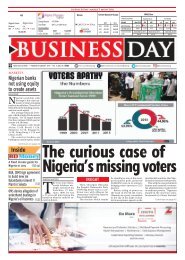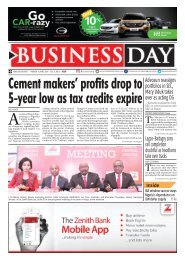BusinessDay 24 May 2017
You also want an ePaper? Increase the reach of your titles
YUMPU automatically turns print PDFs into web optimized ePapers that Google loves.
Wednesday <strong>24</strong> <strong>May</strong> <strong>2017</strong><br />
In Association with<br />
BUSINESS DAY<br />
23<br />
PensionToday<br />
E-mail: insurancetoday@businessdayonline.com<br />
C002D5556<br />
As multi-fund structure sets to change<br />
pension industry investment dynamics<br />
…carters for individual investment preferences<br />
...variable income instruments get boosts<br />
The multi-fund structure<br />
in the newly<br />
amended investment<br />
guideline recently released<br />
by the National<br />
Pension Commission (PenCom)<br />
when implemented would change<br />
the pension industry investment<br />
dynamics.<br />
Pension Fund Administrators<br />
(PFAs), the mangers of the burgeoning<br />
country’s pension funds<br />
are positive that new scheme<br />
would carter for individual investment<br />
preferences.<br />
Besides that, it will give younger<br />
contributors who still have long<br />
period to retire, theopportunity<br />
ofearning higher returns on investmentin<br />
the variable income<br />
instruments.<br />
PenCom recently released the<br />
amended investment guidelines<br />
introducing multi-fund structure<br />
comprising Fund I, Fund II, Fund<br />
III and Fund IV (Retiree Fund).<br />
Funds I, II, III and IV shall however<br />
differ among themselves according<br />
to their overall exposure to<br />
variable income instruments.<br />
According to the guideline,<br />
the exposure to variable income<br />
instruments is defined as the sum<br />
of a PFA’s investments in ordinary<br />
shares and participation units<br />
of open close-ended and hybrid<br />
funds; real estate investment<br />
trust; infrastructure funds; and<br />
private equity funds comprising<br />
its current holdings and any future<br />
financial commitments to the acquisition<br />
of participation units in<br />
these funds.<br />
Eguarekhide Longe, managing<br />
director/CEO, AIICO Pensions<br />
Limitedsaid the multi-fund structure<br />
means that individual investment<br />
preferences will be catered<br />
for just like in the regular asset<br />
management industry.<br />
Longe, who is also the chairman<br />
of Pension Fund Operators Association<br />
of Nigeria (PenOp) said<br />
for younger contributors capable<br />
of absorbing more risk, they will<br />
have the option of selecting the<br />
funds with larger variable income<br />
exposure, while those who would<br />
rather be more conservative, due<br />
to age, will select the more predictable<br />
fixed income funds. “One size<br />
will not be compelled to fit all as<br />
currently obtains.”<br />
According to him, enhancement<br />
of returns is not the focus of<br />
the new fund structure but rather,<br />
it is for risk predisposition.<br />
Longe further emphasized that<br />
experience over the years show<br />
that variable income investments<br />
(e.g. equities) tend to outperform<br />
other asset classes, so “it is expected<br />
that for those with a longer<br />
term investment horizon, they will<br />
ride the fluctuations over the years<br />
and earn superior return over the<br />
life of the investments that will be<br />
made for them in the portfolios<br />
that are exposed to higher risks.”<br />
Glory Etaduovie, managing<br />
director/CEO, IEI-Anchor Pension<br />
Managers Ltd said that the<br />
multi-fund structure is designed<br />
for proper definition of available<br />
funds for types of investments,<br />
long term and short term to suit<br />
various developmental needs and<br />
stimuli for sustainable growth.<br />
“Pension funds are a delicate<br />
fund which needs to be managed<br />
delicately. It is not free money as<br />
many seem to allude to in recent<br />
developments. It is the people’s<br />
future and it will be immoral to<br />
deal treacherously with the funds<br />
because the future generations<br />
will judge us.”<br />
He noted that the funds are<br />
graded to determine use to which<br />
it may be used safely.<br />
“Portions of funds for those<br />
nearing retirement cannot be<br />
used for long term investments.<br />
Younger contributors will not<br />
need their contributions in the<br />
very near future, so it can be stud-<br />
ied for sustainable development”.<br />
You will observe I keep mentioning’<br />
sustainable development,’<br />
it refers to a well rounded out<br />
investment/development plans<br />
where no sector suffers the aftermath<br />
of lope-sided investment<br />
decisions. It is good for the government;<br />
it is good for the public and<br />
the citizenry.”<br />
According to him, contributors<br />
will make double gain - the<br />
funds will be structured in a way<br />
that nothing that accrues to them<br />
will be taken away. It will also be<br />
wasteful to let the funds lie idle,<br />
not being productive economically.<br />
Contributors are part of the<br />
society and so they will also benefit<br />
from meaningful infrastructural<br />
developments.”<br />
Etaduovie further contended<br />
that everything about the new<br />
fund structure is exciting, as it excites<br />
increased study and financial<br />
intelligence being developed in<br />
the country now.<br />
“It is also going to attract bigger<br />
business ideas needing long<br />
term funds. Everyone stands to<br />
gain - the pension industry will be<br />
seen as a worthy growth and development<br />
partner, the citizenry,<br />
economy and the government will<br />
all gain, Etaduovie stated.<br />
In line with 7.3(a) of the guideline,<br />
the maximum exposure to<br />
variable income instruments by<br />
the Fund types are as follows:<br />
Fund I: 75 percent of portfolio<br />
value; Fund II: 55 percent of portfolio<br />
value; Fund III: 20 percent<br />
of portfolio value and Fund IV: 10<br />
percent of portfolio value.<br />
PFAs are also expected to invest<br />
in such a way that the actual exposure<br />
to variable income instruments<br />
in Fund I is higher than the<br />
exposure in Fund II. Likewise, the<br />
exposure in Fund II shall be higher<br />
than the exposure in Fund III. Accordingly,<br />
the minimum exposure<br />
to variable income instruments<br />
by Fund Type shall be: Fund I:<br />
20 percent; Fund II: 10 percent;<br />
Fund III: 5 percent and Fund IV:<br />
0 percent.<br />
Effective from the date of implementation<br />
of the multi-fund<br />
structure, the PFAs shall allocate<br />
contributors to various fund types<br />
according to the following criteria:<br />
membership of Fund I shall strictly<br />
be by formal request by a contributor;<br />
active contributors who<br />
are 49 years and below as at their<br />
last birthdays shall be assigned to<br />
Fund II; active contributors who<br />
are 50 years and above as at their<br />
last birthdays shall be assigned to<br />
Fund III and Fund IV shall strictly<br />
be for RSA retirees only.<br />
RC634453<br />
Diamond Pension Fund Custodian Limited<br />
1A, Tiamiyu Savage Street, Victoria Island, Lagos State.<br />
Tel: 01-4613753, 2713680, 2713954<br />
Fax: 01-2713955<br />
Email: info@diamondpfc.com<br />
Website: www.diamondpfc.com<br />
This section is<br />
created to increase<br />
awarness and deepen<br />
knowledge about<br />
the contributory<br />
pension scheme.<br />
If you have enquiries<br />
or contributions,<br />
send to this e-mail:<br />
diamondpfcbusday@yahoo.com


















